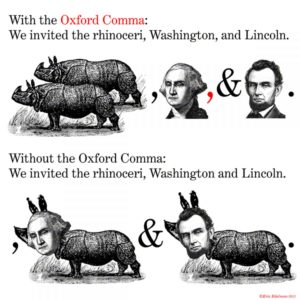Common APA Errors: The Serial Comma
One of the most common errors I come across in the dissertations I edit is lack of or misuse of commas. Today we’re going to talk about one particular type of comma that (I think) is pretty nifty. It’s the “Serial Comma,” also known as the Oxford Comma. It’s the comma before the final item in a list of three or more things.
I’ll tell you the truth: my mother and I have had many battles over the use of the serial comma. I always used it, and she felt it was unnecessary. Fortunately, I’ve since become a dissertation editor in APA style–a style that recommends the use of the serial comma I so love. If I’d opted for a career in journalism, I would have had to abandon it forever.
Why do I love the serial comma? Because using it makes for “clear, unambiguous language,” according to the APA Style Blog. Take this for example:
“For breakfast, I had eggs, toast, and orange juice.” That makes sense. You had some eggs and toast and you drank a glass of orange juice. Now, try this:
“For breakfast, I had eggs, toast and orange juice.” Hm. Do you mean you spread orange juice on your toast? I’m confused.
That’s the thing about the misuse of commas. It can spoil a great breakfast.
You can see the same tragedy at work below, where someone has turned respected historical figures into rhinoceri:

Do you see what I’m getting at? The serial comma is an important part of clear written communication, and clarity is vital to academic writing.
So, let’s see a few examples of the serial comma done right:
“I had lunch with Moe, Larry, and Curly”
“The interview included questions about the participants’ financial well-being, perceived job security, debt, and level of education.”
“While no mammals were selected for the study, we selected several reptiles, including iguanas, geckos, pythons, rattlesnakes, garter snakes, and __.”
“I attended the meeting with my boss, her secretary, and members of upper-management.”
 Waiting to Get Your Dissertation Accepted?
Waiting to Get Your Dissertation Accepted?







